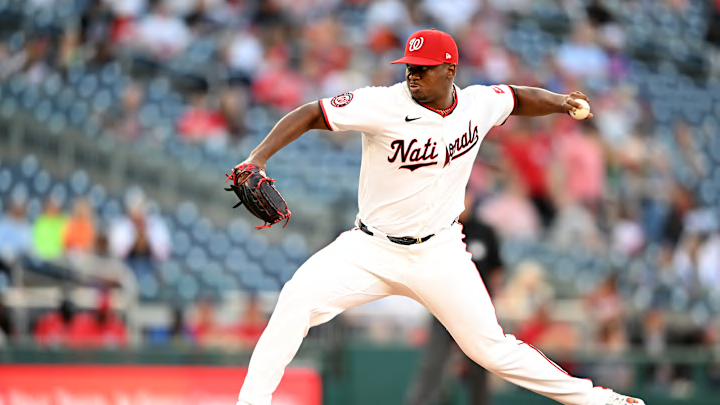On Wednesday and Thursday, Jose A. Ferrer tossed two consecutive scoreless ninth innings to secure the Nationals’ series win over the Mets. The new Nats closer now has four saves on the season and has pitched nine and one third consecutive scoreless innings. For a relief unit that has been historically bad throughout the year and has lost a number of key contributors, Ferrer is a bright spot. Drew Storen, Rafael Soriano, Daniel Hudson, and Kyle Finnegan all had impressive runs closing games for Washington. Now, it is Ferrer’s turn.
Ferrer’s statistics do not stand out on a Baseball Reference page. In 63 innings pitched this season, he has a 4.29 ERA and only 54 strikeouts. His production seems to be only marginally better than his colleagues in the dismal Nationals bullpen. But Ferrer is a complicated pitcher. His recent performance and enigmatic pitching style suggest he has the potential to be an elite reliever.
In the second half of the season, Ferrer has already demonstrated that he is a dominant pitcher. The Dominican left-hander has a 2.03 ERA since the All-Star break after posting a 5.03 ERA in the first half of the season. Even though is a small sample size, Ferrer has shown flashes of All-Star-level production.
Based on data on Baseball Savant, I have noticed that Ferrer has made changes throughout the season, correlating with his improved success. At the beginning of the season, Ferrer released his sinker at an average arm angle of 32 degrees, while his arm angle on his slider and changeup was around 27 and 29 degrees, respectively. Major League hitters can pick up on this slight disparity, helping them potentially identify which pitches Ferrer is throwing. Ferrer, though, has released his pitches from a closer and more consistent arm angle as the season has progressed. This month, Ferrer’s average arm angle on his sinker has been 33 degrees, and his average arm angle on both of his off-speed pitches has hovered around 31 to 32 degrees. With a more consistent arm slot, Ferrer is able to make all three of his pitches look more similar to hitters. He can deceive hitters better when he throws pitches from the same angle.
The lefty has also made small tweaks to his pitch mix. Over the past few months, he has decreased his sinker usage from around 75 percent to 70 percent. Corresponding to this change, he is throwing his slider and changeup more often. Ferrer’s sinker is a strong pitch, but he cannot be a one-trick pony. He is a better pitcher when he incorporates more pitches and has more options to keep hitters off balance.
Ferrer has also found his success in a unique manner. In today’s game, velocity and strikeouts have paramount importance. Pitchers chase velocity to try to induce more swings and misses and strike out more batters. However, flame-throwing pitchers often sacrifice control, which gives them high walk rates. Former Nationals General Manager Mike Rizzo infamously declared that he did not care how hard his pitchers threw ball four.
Ferrer throws hard. His average sinker velocity is 97.6 miles per hour. Still, he bucks the trend of high-velocity pitchers striking out and walking lots of hitters. This season, Ferrer’s strikeout rate is just under the league average of 20.7 percent, and his walk rate sits at the extraordinarily low mark of 4.6 percent; the league average walk rate for pitchers is around eight or nine percent. He is a rare pitcher who throws hard but is susceptible to neither walks nor strikeouts.
Overall, Ferrer induces balls in play. This pitching-to-contact approach is not only aesthetically pleasing by resulting in more action, it also is effective. When batters make contact off of Ferrer, they usually hit it softly and on the ground. The league average groundball rate for pitchers is around 42 percent, while Ferrer has an elite groundball rate of 63.7 percent, and the average exit velocity on hits against him is 88.6 miles per hour, which is lower than the league average on hits. Ferrer’s sinker misses barrels and forces soft contact. He can maintain success by continuing to utilize the above average pitch he already has.
Ferrer, though, can build on top of his slider and changeup more often. Ferrer uses his changeup, a pitch that is traditionally productive against opposite-handed batters, against right-handers, and his slider, a pitch traditionally productive against same-handed batters, against lefties. This season, both of his off-speed pitches have whiff rates of 44 percent, and his sinker only has a whiff rate of about 15 percent. By throwing his off-speed pitches more, Ferrer can generate more strikeouts and build on his ability to generate ground balls. Still, Ferrer should primarily rely on his sinker, as he is already proving that it is a quality primary pitch.
Ferrer is already pitching well this season, but if he can mix in more secondary offerings with his sinker, the Nationals will have an All-Star closer once again.
